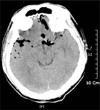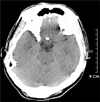Abstract
We report a patient who developed symptomatic pneumocephalus after surgery for a spinal intradural tumor. A 30-year-old man presented with low back pain and leg pain was presented. Magnetic resonance image (MRI) demonstrated an well-demarcated intradural extramedullary tumor at the L3-4. The mass had little adhesion rootlets at its base. So, we achieved en-bloc total resection without any difficulty. The patient had no postoperative problems immediately after the surgery such as cerebrospinal fluid (CSF) leakage. However, he began to suffer from headache and restlessness about 8 hours after sitting position. Computed tomography (CT) scan revealed pneumocephalus in bilateral sylvian cistern and basal cistern. He was successfully managed conservatively. Although not being CSF leakage or fistula, pneumocephalus developed especially after removal of intradural extramedullary tumor in spine. We think that the air might be entrapped into surgical cavity when tumor burden was en-bloc removed. When the patient was in upright position, subarachnoid air migrated from the spine into the brain.
Pneumocephalus is defined as the presence of air or gas within the cranial cavity. It is a relatively common complication of basal skull fractures, brain abscesses, and bone erosion as a result of an intracranial tumor and cerebrospinal fluid (CSF) diversion procedures.2,5,7,11) Although most cases of pneumocephalus resolve spontaneously, pneumocephalus occupying a large space in the intracranial cavity leads to the development of headache, restlessness, confusion, disorientation and neurologic deterioration, which sometimes requires surgical procedures.1,5,7,13,17) A subarachnoidpleural fistula following thoracic spinal fracture associated with a pneumothorax and thoracotomy for a Pancoast tumor may also result in pneumocephalus.6,8,16) However, there are only a few studies documenting pneumocephalus associated with spinal surgery.10,14) We report a case of symptomatic pneumocephalus after surgery for a spinal intradural tumor.
A 30-year-old man presented with a 12-month history of increasing low back and bilateral leg pain. On physical examination, there was no significant neurological abnormality detected. A magnetic resonance imaging (MRI) scan of the lumbar spine demonstrated a well-demarcated, intradural extramedullary tumor at the level of L3-4. The lesion appeared hyperintense on a T1-weighted image after intravenous contrast injection (Figure 1). After unilateral laminectomy with bilateral decompression at L3 and 4, we opened the dura; this exposed a pinkish, solid, encapsulated mass that measured 1.0×1.4×1.2 cm, arising from the filum terminale and overlying adherent nerve roots of the cauda. Microscopy revealed that the mass appeared to have no rootlets adherent to its base. We performed an en-bloc total resection. We then flushed the surgical cavity out continuously with normal saline. The dura was closed with tissue adhesives so it would be watertight. Histopathological examination identified the tumor as a myxopapillary ependymoma. It revealed cuboidal to elongated tumor cells radially arranged in a papillary manner and around the vascularized stromal cores in a mucoid background (Figure 2). The patient had no problem postoperatively such as CSF leakage. We encouraged the patient to assume a sitting position after 6 hours.
The patient presented with late onset headache after sitting position. Although he was administered analgesics, he became worse with the development of restlessness. A computed tomography (CT) scan showed pneumocephalus bilaterally in the sylvian and basal cisterns (Figure 3). The patient experienced a full recovery with bed rest and hyperhydration.
On the 10th postoperative day, a follow-up CT scan was free of air in the subarachnoid space in the brain (Figure 4). The patient was discharged without any neurological sequelae on the 14th postoperative day.
The most frequent cause of pneumocephalus is head trauma followed by intracranial neoplasms, infections, neurosurgery, paranasal surgery, and diagnostic or neurosurgical interventions such as a lumbar puncture.2,4,5,7,11) A skull fracture with a dural tear allows the communication of air into the subarachnoid space, resulting in pneumocephalus. The mechanism responsible for pneumocephalus is explained by the following two factors. First, the ball-valve mechanism explains that air enters the intracranial cavity through a defect whenever the extracranial pressure exceeds the intracranial pressure.13) Second, the inverted bottle mechanism explains that continuous leakage of CSF results in a relatively negative intracranial pressure, thereby allowing replacement of lost fluid by air.11,13) Pathophysiologically, the mechanism of development of pneumocephalus associated with spinal surgery was also based on these factors.10,14) Most surgeons already know about the possibility of developing pneumocephalus after many kinds of surgeries involving opening of the dura. Therefore, surgeons usually pay careful attention to minimize CSF leakage and continue to irrigate saline continuously into the surgical cavity during the surgery. However, a review of the literature revealed that there have been no reports except a few papers10,14) about the development of pneumocephalus after surgery for a spinal intradural tumor. Ozturk et al. reported that a patient who underwent pedicle screw fixation for thoracolumbar scoliosis developed pneumocephalus after the surgery. A pedicle screw coursed through the spinal canal at the L2 level, and it resulted in a dural tear and CSF leakage. Pneumocephalus associated with infratentorial and supratentorial hemorrhage developed due to a negative intracranial pressure.10) Turgut et al.14) reported that a symptomatic tension pneumocephalus developed due to iatrogenic CSF leakage following surgical intervention and drainage with a vacuum suction device for a lumbar disc herniation. A thoracic spine fracture or thoracotomy may result in dural and pleural tears resulting in a subarachnoid-pleural fistula, leading to the development of pneumocephalus associated with a pneumothorax.6,8,16)
Air within the spinal canal is defined as pneumorrhachis.9) The subarachnoid space extends from the basal cisterns surrounding the brainstem superiorly to its termination at the level of the sacral vertebra. In the case of a skull fracture, subarachnoid pneumorrhachis is resulted from pneumocephalus, whereby air from the subarachnoid space of the brain migrates into the spine; this usually occurs when the patient is in the face-down position, letting air migrate through the foramen magnum.3) However, in our case, the contrary occurred. We think that the air might have been entrapped in the surgical cavity when the tumor burden was removed en-bloc. When the patient assumed a head-up position during the postoperative period, the subarachnoid air migrated from the spine into the brain. That is to say, that air floats up the spinal canal into the brain.
Pneumocephalus usually tends to reabsorb with conservative management. It requires bed rest and hyperhydration. However, tension pneumocephalus is symptomatic and associated with severe headache and restlessness or even neurological deterioration. It requires immediate surgical procedures.5,7,13) These include simple aspiration through burr holes,1) use of a closed water-seal drainage system to promptly reduce the intracranial pressure and to maintain the persistent pressure gradient between intracranial and extracranial for closure of the dural fistula,1,7) or reconstruction of the injured sites.17)
It requires attention to prevent pneumocephalus from developing during spinal tumor surgery. Turgut et al. recommends that inhalational nitrous oxide not be used; they also recommend that using 5 cmH20 positive end-expiratory pressure (PEEP) may reduce the occurrence of pneumocephalus by increasing the intrathoracic pressure and minimizing the negative pressure effect that occurs during surgery for a spinal intradural tumor.15) The tumor should be removed meticulously. One then needs to flush out the air in the surgical cavity completely with continuous normal saline to prevent its entering into the surgical cavity, prior to closing the dural mater. Furthermore, there needs to be a watertight dural closure to minimize CSF leakage and maintenance of adequate hydration for proper cerebral perfusion.12)
Figures and Tables
FIGURE 1
Sagittal T1-weighted (A), T2-weighted (B), and contrast enhanced T1-weighted (C) MRI images show a well-defined intradural extramedullary mass at the L3-4. The mass has sharply defined rostral and caudal margins and exhibit intermediate signal intensity. There is a small cyst capping the caudal pole of the tumor. The tumor shows strong homogenous enhancement except for cystic portion.

References
1. Arbit E, Shah J, Bedford R, Carlon G. Tension pneumocephalus: treatment with controlled decompression via a closed water-seal drainage system. Case report. J Neurosurg. 1991; 74:139–142.
2. Cihangiroğlu M, Unal B, Ozdemir H, Yildirim H, Ogur E. Pictorial essay: pneumocephalus. Tani Girisim Radyol. 2003; 9:31–35.
4. Guarino AH, Wright NM. Pneumocephalus after a lumbar epidural steroid injection. Pain Physician. 2005; 8:239–241.

5. Hong WJ, Yoo CJ, Park CW, Lee SG. Two cases of delayed tension pneumocephalus. J Korean Neurosurg Soc. 2005; 37:59–62.
6. Katz DS, Groskin SA, Wasenko JJ. Pneumorachis and pneumocephalus caused by pneumothorax and multiple thoracic vertebral fractures. Clin Imaging. 1994; 18:85–87.

7. Kim JW, Lee SH, Lee KS, Ko KC, Kim HK, Khang CG, et al. Post-traumatic tension pneumocephalus of delayed onset. J Korean Neurosurg Soc. 2002; 31:289–292.
8. Ladehoff M, Zachow D, Koch C, Nowak G, Echelmeyer A, Arnold H, et al. Cerebellar haemorrhage and tension pneumocephalus after resection of a Pancoast tumour. Acta Neurochir (Wien). 2005; 147:561–564.

9. Newbold RG, Wiener MD, Vogler JB 3rd, Martinez S. Traumatic pneumorrhachis. AJR Am J Roentgenol. 1987; 148:615–616.

10. Ozturk E, Kantarci M, Karaman K, Basekim CC, Kizilkaya E. Diffuse pneumocephalus associated with infratentorial and supratentorial hemorrhages as a complication of spinal surgery. Acta Radiol. 2006; 47:497–500.

11. Pitts LH, Wilson CB, Dedo HH, Weyand R. Pneumocephalus following ventriculoperitoneal shunt. J Neurosurg. 1975; 43:631–633.

12. Prabhakar H, Bithal PK, Ghosh I, Dash HH. Pneumorrhachis presenting as quadriplegia following surgery in the prone position. Br J Anaesth. 2006; 97:901–903.

13. Sprague A, Poulgrain P. Tension pneumocephalus: a case report and literature review. J Clin Neurosci. 1999; 6:418–424.

14. Turgut M, Akyuz O. Symptomatic tension pneumocephalus: an unusual post-operative complication of posterior spinal surgery. J Clin Neurosci. 2007; 14:666–668.

15. Turgut N, Turkmen A, Gokkaya S, Hatiboglu MA, Iplikcioglu AC, Altan A. Positive end-expiratory pressure reduces pneumocephalus in spinal intradural tumor surgery. J Neurosurg Anesthesiol. 2007; 19:161–165.

16. Uemura K, Meguro K, Matsumura A. Pneumocephalus associated with fracture of thoracic spine: case report. Br J Neurosurg. 1997; 11:253–256.




 PDF
PDF ePub
ePub Citation
Citation Print
Print





 XML Download
XML Download